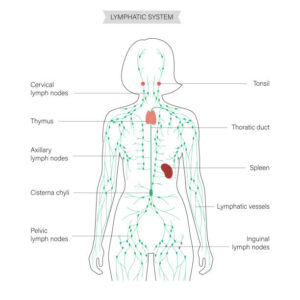Lymphology:
The study of the Lymphatic System. A branch of medical science concerning disorders related to the lymphatic vessels and nodes.

What is the Lymphatic System?
The lymphatic system (LS) is an amazing and complex structure, that is part of our circulatory system. Most people are aware of their cardiovascular system, but less commonly aware that the cardiovascular system is only a part of their overall circulatory system. It’s been said that the Lymphatic System is the “stepchild” of our body.
The Cardiovascular system, with the help of red blood cells (RBC), carries and distributes nutrients, oxygen, neurotransmitters, chemicals and hormones to distal parts of our body through arteries and arterioles. The RBCs and their cargo are dropped off in the tissues for cell use.
The target cells use these substances and create waste products in return. The Capillaries pick up these RBCs and wastes and carries them in veins to filter the blood through the kidneys and liver before returning to the heart and lungs to do it all over again.
The Lymphatics are a series of veins that run from distal parts of our body toward the heart but don’t have a set of arteries leaving the heart. The LS is a one-way system. The LS houses a high concentration of white blood cells and T-cells that are responsible for our immune response. When wastes such as large proteins, fat cells and pathogens are unable to move back into the smaller capillaries of the cardiovascular system the lymphatic system picks them up and moves them through progressively larger lymphatic vessels to lymph nodes. The human body has between 700-1000 lymph nodes depending on the person. The lymph nodes are the functional part of the lymphatic system where the wastes are churned up inside the nodes and attacked with the WBCs. Phagocytosis (cell eating) takes place and the large wastes products and pathogens are disarmed and crushed up before being returned to our blood stream for disposal.
The veins pick up 80-90% of the fluids that leak from the arteries and there in only a percentage of the cellular waste products from the area. Imagine a bath tub with a drain that will pass 90 gallons in a day and a faucet that lets in 100 gallons in a day. Without an over flow drain, that tub will spill over onto the floor by the end of the day. The spill over of fluids in our hands or feet is exactly like that bath tub. Edemas can form anywhere in the body but are most common in the limbs.
In addition to edemas, cancers form where cells are forced to mutate to survive in toxic environments. Remember, our cells are eating and excreting in the same pool of fluids. Too many toxins surrounding a cell prevent nutrients from moving in and toxins from moving out. Cells reprogram and mutate to survive. Our bodies are designed to fight off these cancer cells but sometimes lose that fight.
With less emphasis on life threatening pathologies, the most common illnesses that we face daily are also combated by the lymphatic system. Opportunistic pathogens can over grow in our bodies if our immune systems are unable to mount an appropriate defense. The outcome could be the common cold, yeast infections, sinus infections, urinary tract infections, infectious skin infections, staph infections, systemic swelling and pain and more. The list is endless.
The LS has the task of picking up the left over 10 – 20% of fluids preventing edemas and illness. If 10 – 20% doesn’t sound like much, know that a cup of coffee is only 4% coffee and 96% water. There’s a big difference between a cup of coffee and a glass of water. In fact, without our lymphatic system, we wouldn’t survive more than 2-3 days.
Since the LS is only a one-way system moving toward the heart, it doesn’t have the muscular contractions of the heart to propel the fluids and wastes forward. It relies on the rhythmic pressures created from body movement. 70% of the lymphatics are superficial and moveable through manual lymphatic drainage techniques. 30% of the body’s lymphatics are deep and only moveable through kinesthetic movements of the body. If the lymphatic system is overloaded or sluggish from a lack of movement (as common in bed ridden patients) the body’s ability to fight off these common pathogens is reduced.
Although there is a lot more to our LS, that’s what it is in a nutshell. If you navigate through the rest of this site, you’ll realize that more knowledge about the LS will help you become more intentional about caring for it and preventing things that may cause it harm and to become stagnant. Remember: IF YOU GIVE YOUR BODY WHAT IT NEEDS, IT WILL OFTEN HEAL ITSELF.
Near-Infrared Fluorescence Imaging Technologies
These are some amazing videos where you can see how the lymph flow is moving on both arms. They identify lymphatic drainage areas.
These videos use mapping through fluoroscopy.
They use ICG (Indocyanine Green) injection.
Indocyanine Green (ICG) is a relatively new imaging technique.
This technique allows for quick visualization of superficial lymph flow in real-time, without radiation exposure. This imaging is useful for diagnosing and assessing lymphedema.
Lymph vs. Blood One is well known and the other is obscure for most Americans. Both are body liquids very vital to human life. Lymph fluid is important for the circulatory system, immune function and digestion.
Did you know?
LYMPH fluid is composed of Lymphatic Loads; a term referring to substances that leave the tissue areas via the lymphatic system. The Lymphatic Loads include protein, water, cellular components, particles, and fat. Each load plays an important role in your body, before it returns to the bloodstream via the thoracic duct, and into the left venous angle and right lymphatic duct.

